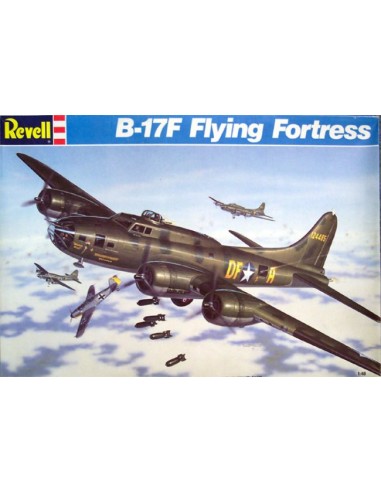|
Developmental History
The venerable B-17 Flying Fortress is probably one of the most recognizable aircraft of World War 2. At least three primary versions with innumerable sub-versions saw action during the war. This aircraft along with the B-24 was responsible for the demolition of the Nazi infrastructure ultimately eliminating their ability to feed the war machine. Initially Boeing produced and shipped “E” model B-17s, which were the version present at Pearl Harbor during the Japanese attack. Although the “E” model was built exclusively by Boeing by 1942 the demand for this bomber was so great that production was subcontracted to the Vega division of Lockheed and the Douglas plant at Long Beach, California. These facilities never produced the “E” model but began production with the “F” model. The B-17F was externally almost identical to the earlier B-17E. Externally, the F could be distinguished from the E only by the use of a single piece plastic blown transparent nose. Apart from the optically-flat bomb aiming panel, the nose transparency was frameless. However, there were over 400 internal changes, designed to make the bomber a more effective fighting machine. Improvements included a Sperry ball turret in the belly of the bomber, external bomb racks, wider paddle-bladed propellers, dual braking systems, additional machine gun mounts in the nose and newer Wright R-1820-97 Cyclone engines that offered war emergency power. The first B-17F (41-24340) from Boeing flew on May 30, 1942 while the first Vega unit (42-5705) flew on May 4, 1942. Because of the many small changes constantly being introduced to the B-17F production line a block designation scheme had to be introduced to make it possible for field maintenance units to keep track of different varieties of B-17Fs that were in service. Each “block” was a group of fifty units with the first block being B-17F-1-VE (Vega) and the second block being –5 and –10 and so on to block 50 at which time the plant switched to the “G” model. Douglas block production ran from block-1-DL to block-85-DL for a total of 605 units at which time they too shifted to the “G” model. As far as Boeing block production was concerned, the first 50 were B-17F-1-BO, the second 50 were -5, and the third 50 were -10, but the numbers in each block varied from this point on. Boeing built a total of 2300 B-17Fs, the last production block being -130-BO. A total of 3405 B-17Fs were built--2300 by Boeing, 605 by Douglas, and 500 by Lockheed-Vega. The B-17F went into action with the 8th Air Force in Europe, and was used for the first American bombing raid against the German homeland on January 27, 1943 in a raid on Wilhelmshaven. It was soon revealed that it was vulnerable to attack from the front by enemy fighters. Factory installed armor plate was not well positioned and the crew were relatively unprotected from frontal machine gun and cannon attack. Many field modifications were carried out in an attempt to correct this including additional machine guns firing from the nose cone or from windows cut into the sides of the fuselage. The Memphis Belle displayed some of these modifications with four machine guns mounted in the nose. The maximum bombload of the first B-17Fs was 9600 pounds but on typical missions the load was 4000-5000 pounds over operating ranges of 1400 miles. Under certain conditions, eight 1600-pound bombs could be carried internally and two 4000-pound bombs externally, raising the total load to 20,800 pounds. However, with such a load the effective range was quite small and all maneuvers were severely restricted. One B-17F (Serial number 42-3521) was transferred to the US Navy. It was given the Navy serial number of 34106, but was operated under its Army designation. It was later modified to B-17G standard and redesignated PB-1. B-17F 41-24613 was turned over to the National Advisory Committee for Aeronautics (NACA) for extensive performance testing under the designation XB-17F. Despite its designation, it was not a prototype. Currently only three B-17Fs remain in existence today, these aircraft are B-17F-10-BO 41-24485 Memphis Belle which is under restoration, B-17F-50-DL 42-3374 which is in storage at Offutt AFB, Nebraska and B-17F-70-BO 42-29782 which is the only flying B-17F in existence and was used in the 1989 remake of “The Memphis Belle”.
|



